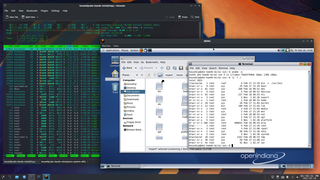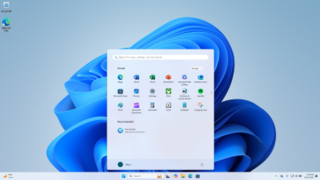
A mobile processor is a microprocessor designed for mobile devices such as laptops, and cell phones.
In software engineering, a compatibility layer is an interface that allows binaries for a legacy or foreign system to run on a host system. This translates system calls for the foreign system into native system calls for the host system. With some libraries for the foreign system, this will often be sufficient to run foreign binaries on the host system. A hardware compatibility layer consists of tools that allow hardware emulation.

QEMU is a free and open-source emulator. It emulates a computer's processor through dynamic binary translation and provides a set of different hardware and device models for the machine, enabling it to run a variety of guest operating systems. It can interoperate with Kernel-based Virtual Machine (KVM) to run virtual machines at near-native speed. QEMU can also do emulation for user-level processes, allowing applications compiled for one architecture to run on another.

Snapdragon is a suite of system-on-a-chip (SoC) semiconductor products for mobile devices designed and marketed by Qualcomm Technologies Inc. The Snapdragon's central processing unit (CPU) uses the ARM architecture. As such, Qualcomm often refers to the Snapdragon as a "mobile platform". Snapdragon semiconductors are embedded in devices of various systems, including vehicles, Android, Windows Phone and netbooks. In addition to the processors, the Snapdragon line includes modems, Wi-Fi chips and mobile charging products.

Windows RT is a mobile operating system developed by Microsoft. It is a version of Windows 8 or Windows 8.1 built for the 32-bit ARM architecture (ARMv7). First unveiled in January 2011 at Consumer Electronics Show, the Windows RT 8 operating system was officially launched alongside Windows 8 on October 26, 2012, with the release of three Windows RT-based devices, including Microsoft's original Surface tablet. Unlike Windows 8, Windows RT is only available as preloaded software on devices specifically designed for the operating system by original equipment manufacturers (OEMs).

Microsoft Surface is a series of touchscreen-based personal computers, tablets, and interactive whiteboards designed and developed by Microsoft, most of them running the Windows operating system. They are designed to be premium devices that set examples for manufacturers of other Windows-compatible products. It comprises several generations of hybrid tablets, 2-in-1 detachable notebooks, a convertible desktop all-in-one, an interactive whiteboard, and various accessories, many with unique form factors. The majority of devices in the Surface lineup are based on Intel processors and compatible with Windows 10 or Windows 11.

The Nokia Lumia 2520 is a Windows RT tablet computer originally developed by Nokia. It is Nokia's first and only Windows-based tablet, and the company's first tablet since its Nokia Internet Tablet line. Sharing its design and marketed with the Nokia Lumia series of Windows Phone products, the device incorporates a quad-core Snapdragon 800 chip with 4G LTE support, along with a 10.1-inch (26 cm) 1080p display and an optional "Power Keyboard" dock adding additional battery capacity, USB ports, and a physical hardware keyboard. Following a period of speculation and leaks, the Lumia 2520 was officially unveiled on 22 October 2013, and released in North America on 21 November 2013.

The Nokia X family was a range of budget smartphones that was produced and marketed by Microsoft Mobile, originally introduced in February 2014 by Nokia. The smartphones run on the Nokia X platform, a Linux-based operating system which was a fork of Android. Nokia X is also known generally as the Nokia Normandy. It is regarded as Nokia's first Android device during the company's Microsoft partnership and was in the process of selling its mobile phone business to Microsoft, which eventually happened two months later.
Surface Mini is an unreleased tablet computer that Microsoft designed as the successor to the Surface 2 in the Microsoft Surface family. The device has a Qualcomm Snapdragon 800 processor and a 7.5-inch (19 cm) 4:3 aspect ratio touchscreen display that defaults to portrait mode. Like its predecessor, the Surface Mini runs Windows RT 8.1, a mobile operating system that was designed for the ARM architecture and has limitations including an inability to install Win32 applications; programs can only be installed from the Windows Store.
Qualcomm Kryo is a series of custom or semi-custom ARM-based CPUs included in the Snapdragon line of SoCs.
The Surface Laptop 3 is a laptop computer developed by Microsoft. It is the third generation of Surface Laptop and was unveiled alongside the Surface Pro 7 and Surface Pro X on an event on 2 October 2019. It succeeds the Surface Laptop 2 that was released in October 2018.
The Surface Duo is a dual-touchscreen Android smartphone manufactured by Microsoft. Announced during a hardware-oriented event on October 2, 2019, and officially released on September 10, 2020, it is part of the Microsoft Surface series of touchscreen hardware devices, and the first device in the line that does not run Windows. It also marks Microsoft's first smartphone since the dissolution of Microsoft Mobile and the Windows Phone platform.

The Surface Pro X is a 2-in-1 detachable tablet computer developed by Microsoft. It was developed alongside and was announced on 2 October 2019 alongside the Surface Pro 7 and Surface Laptop 3. Updated hardware was announced alongside Surface Laptop Go and Surface accessories on October 1, 2020 and September 22, 2021. The device starts at $899.99 USD / £849.99.

Windows 11 is the latest major release of Microsoft's Windows NT operating system, released on October 5, 2021. It succeeded Windows 10 (2015) and is available for free for any Windows 10 devices that meet the new Windows 11 system requirements.
The Surface Laptop is a line of laptops marketed by Microsoft, as a sub-brand of their Surface devices. Several models have been produced:

The Microsoft Surface Pro 9 is a 2-in-1 detachable tablet computer developed by Microsoft to supersede the Surface Pro 8 and Surface Pro X, merging both brands. The device was announced on October 12, 2022 introducing two new colors and alongside the Surface Laptop 5 and Surface Studio 2+. The tablet is powered by the new Windows 11 operating system, and features 12th generation Intel Core processors or the ARM-based Microsoft SQ3 processor on 5G models.
Windows Dev Kit 2023 is an ARM-based compact desktop computer for software developers, developed by Microsoft. It was announced during the Build conference on May 24, 2022, and was released on October 24, 2022.
The Surface Laptop 7th Edition is a laptop computer developed by Microsoft. It is the seventh generation of Surface Laptop, and was unveiled alongside the Surface Pro 11th Edition. It is the first Surface Laptop released for Windows on ARM. It's also the first Surface Laptop with a built-in NPU designed for generative AI, via Microsoft Copilot+
Lunar Lake is the codename for the upcoming Series 2 Core Ultra processors designed by Intel, set for release in the second half of 2024. It is set to follow on from Meteor Lake which saw Intel move from monolithic silicon to a disaggregated MCM design. Meteor Lake was limited to a mobile release while Arrow Lake includes both socketable desktop and mobile processors.









